The McEliece
Cryptosystem
�
Introduction
This public key cryptosystem, introduced by McEliece
in 1978, is similar to the Merkle-Hellman Knapsack
cryptosystem in that it takes an easy case of an NP-
problem and disguises it to look like the hard instance of
the problem. In this cryptosystem, the problem that is
used is drawn from the theory of error-correcting codes.
�
The Problem
Syndrome decoding of linear codes (when considered as a decision
problem) is an NP-complete problem if the number of errors is not
bounded. However, there are classes of linear codes which have
very fast decoding algorithms. The basic idea of the McEliece
system is to take one of these linear codes and disguise it so that
Oscar, when trying to decrypt a message, is forced to use
syndrome decoding, while Bob, who set up the system, can remove
the disguise and use the fast decoding algorithm. McEliece
suggested using Goppa Codes, which are linear codes with a fast
decoding algorithm, in the system, but any linear code with a good
decoding algorithm can be used.
�
The Cryptosystem
k invertible matrix (the
n permutation matrix (i.e., having a
Let C be an [n,k]-linear code with a fast decoding algorithm that
can correct t or fewer errors. Let G be a generator matrix for C. To
create the disguise, let S be a k ·
scrambler) and let P be an n ·
single 1 in each row and column and 0's everywhere else). The
matrix,
G' = SGP
is made public while S, G and P are kept secret by Bob. For Alice
to send a message to Bob, she blocks her message into binary
vectors of length k. If x is one such block, she randomly constructs
a binary n-vector of weight t (that is, she randomly places t 1's in a
zero vector of length n), call it e and then sends to Bob the vector
y = xG' + e.
�
The Cryptosystem
Oscar, upon intercepting this message, would have to find the
nearest codeword to y of the code generated by G'. This would
involve calculating the syndrome of y and comparing it to the
n
syndromes of all the error vectors of weight t. As there are of
these error vectors, good choices of n and t will make this
computation infeasible.
t
Bob, on the other hand, would calculate
yP-1 = (xG' + e)P-1 = xSG + eP-1 = xSG + e'
where e' is a vector of weight t (since P-1 is also a permutation
matrix). Bob now applies the fast decoding algorithm to strip off the
error vector e' and get the code word (xS)G.
�
The Cryptosystem
The vector xS can now be obtained by multiplying by G-1 on the
right (however, if Bob had been smart, he would have written G in
standard form [I
positions of xSG and this multiplication would not be needed).
Finally, Bob gets x by multiplying xS on the right by S-1.
A], and then xS would just be the first k
k
For McEleice's Goppa Code example, n = 1024 and t = 50 which
gives Oscar more than 1080 syndromes to calculate.
�
An Example
For an example we shall use the (7,4) Hamming code which
corrects all single errors. A generator matrix for this code is given
by (note the clever choice):
G=1 0 0 0 1 1 0
S =1 1 0 1
0 1 0 0 1 0 1
0 0 1 0 0 1 1
0 0 0 1 1 1 1
1 0 0 1
0 1 1 1
1 1 0 0
and Bob chooses the scrambler matrix
�
An Example
and the permutation matrix
P=0 1 0 0 0 0 0
G '=S G P=1 1 1 1 0 0 0
0 0 0 1 0 0 0
0 0 0 0 0 0 1
1 0 0 0 0 0 0
0 0 1 0 0 0 0
0 0 0 0 0 1 0
0 0 0 0 1 0 0
1 1 0 0 1 0 0
1 0 0 1 1 0 1
0 1 0 1 1 1 0
Bob makes public the generator matrix
�

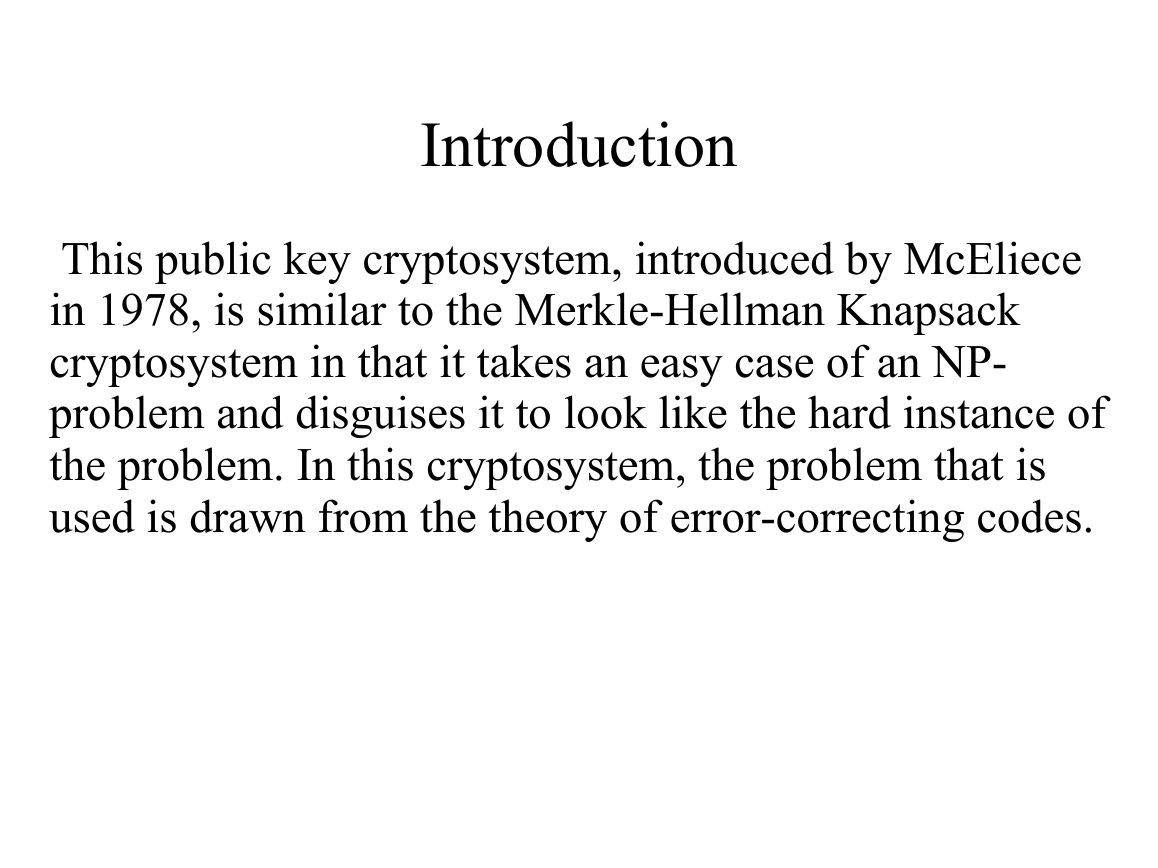
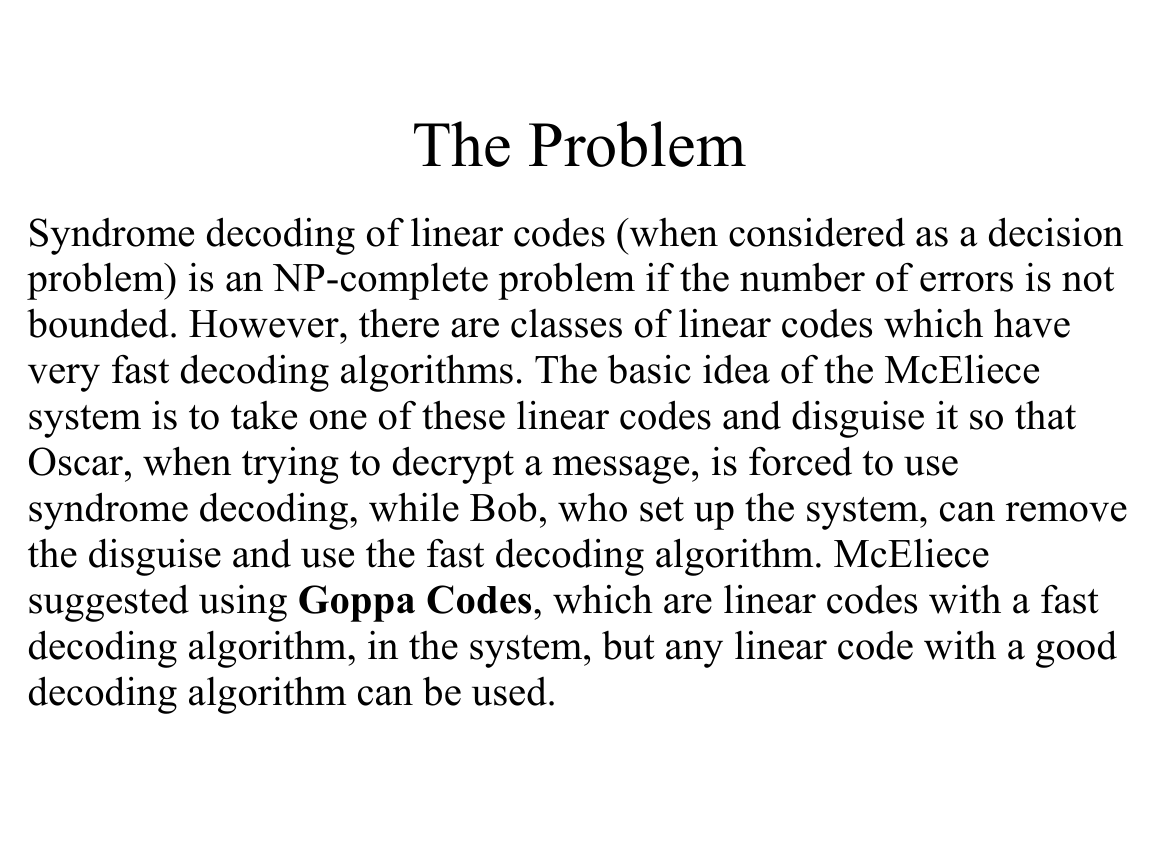
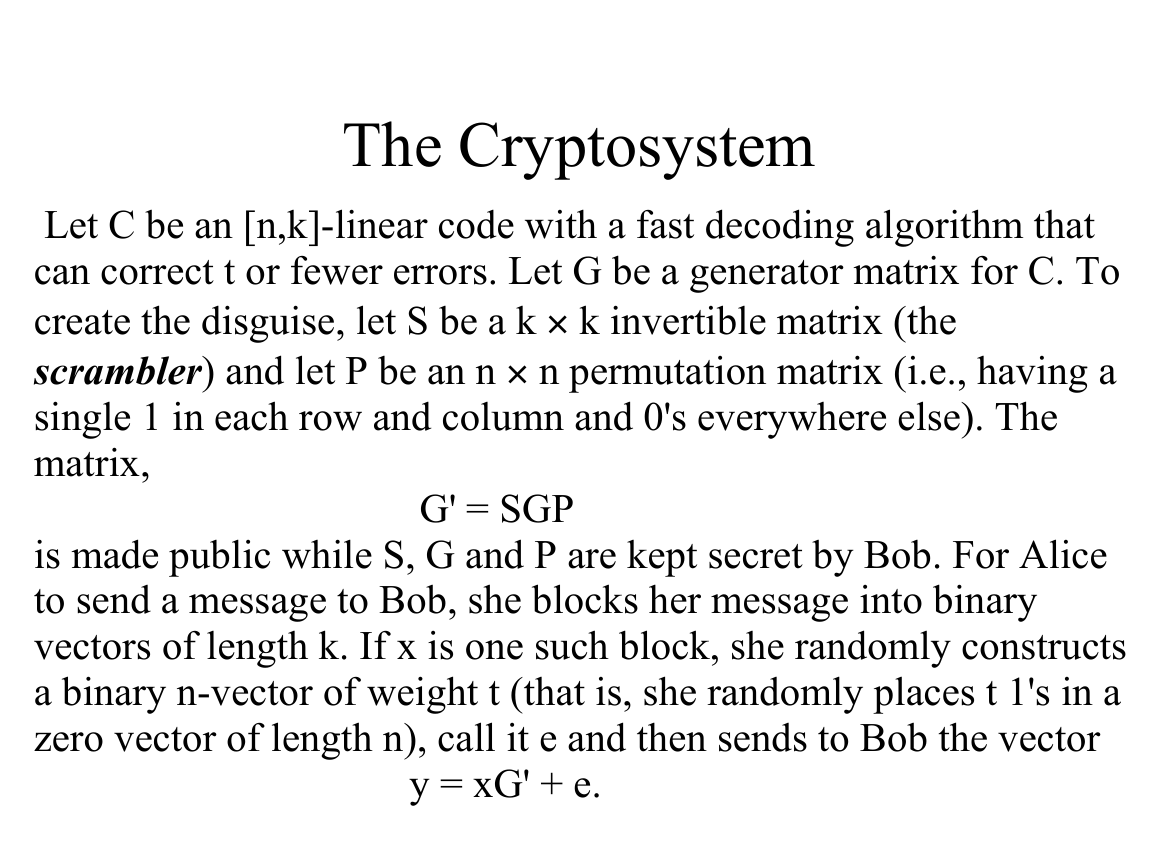
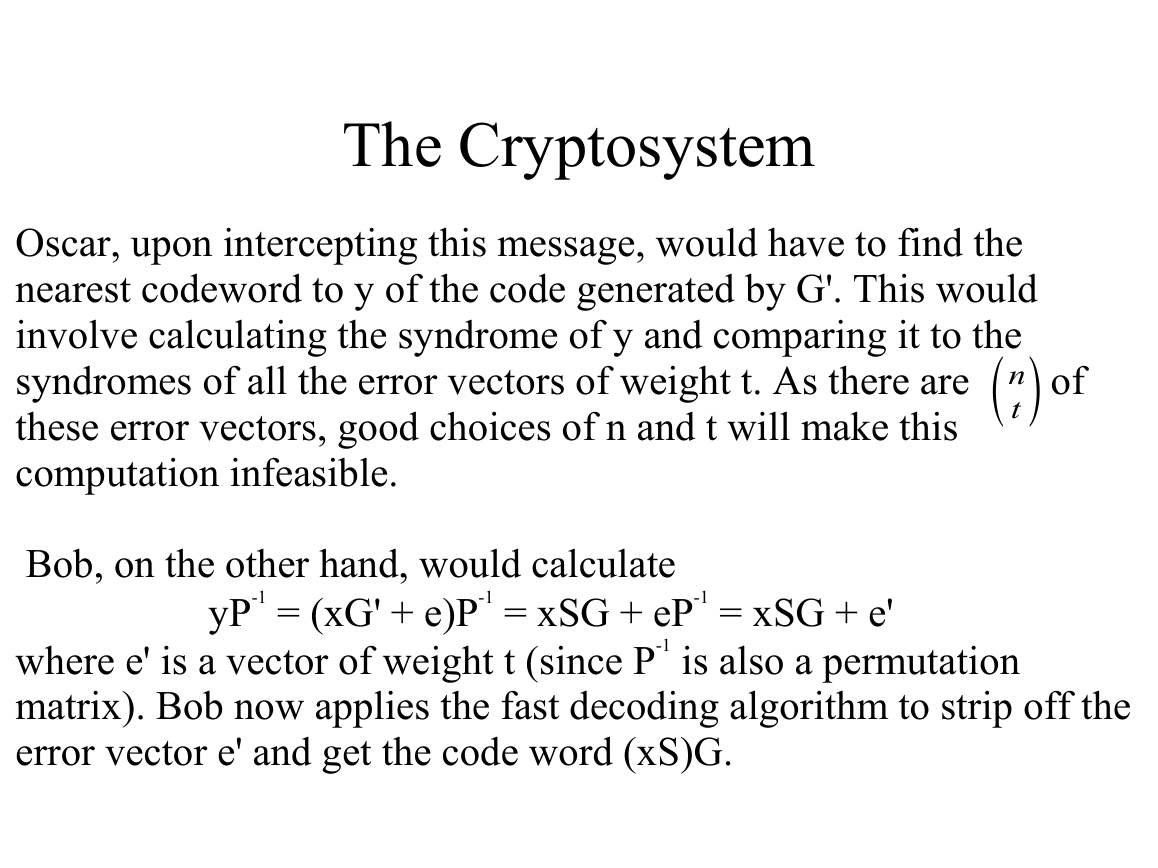
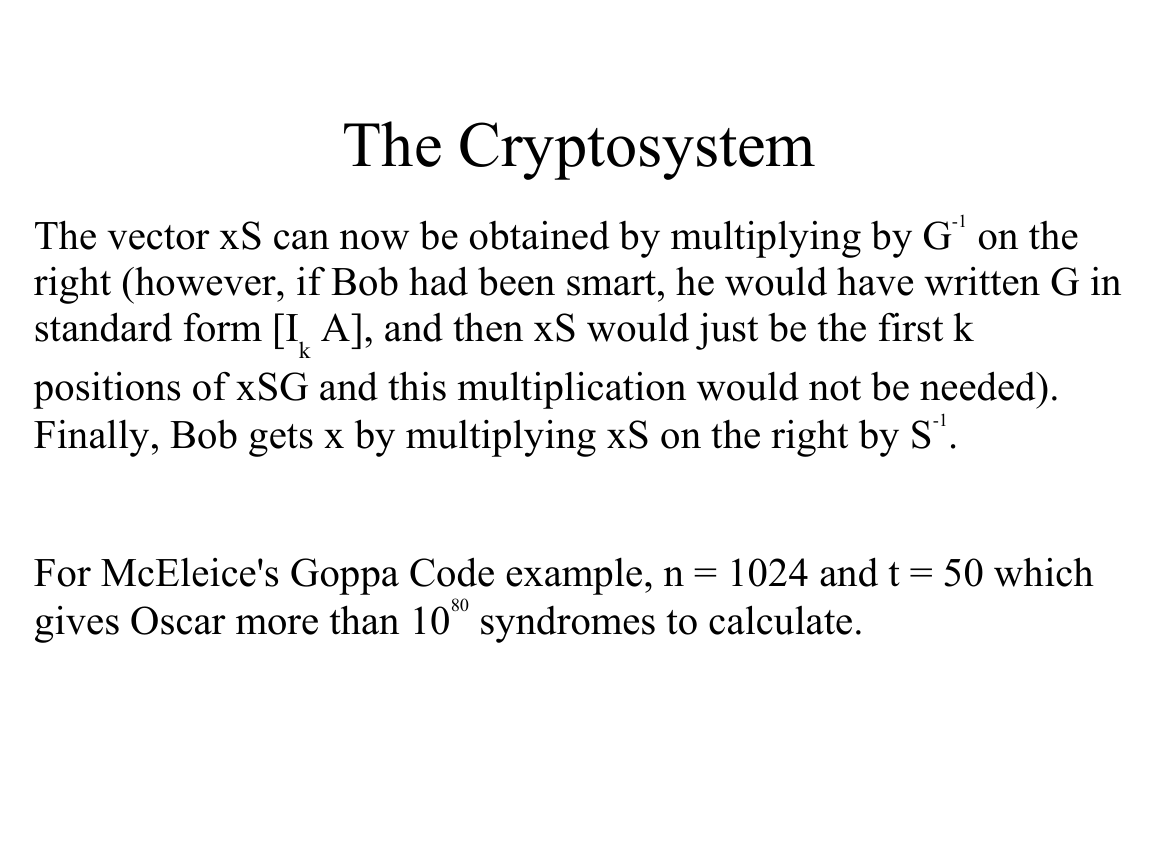
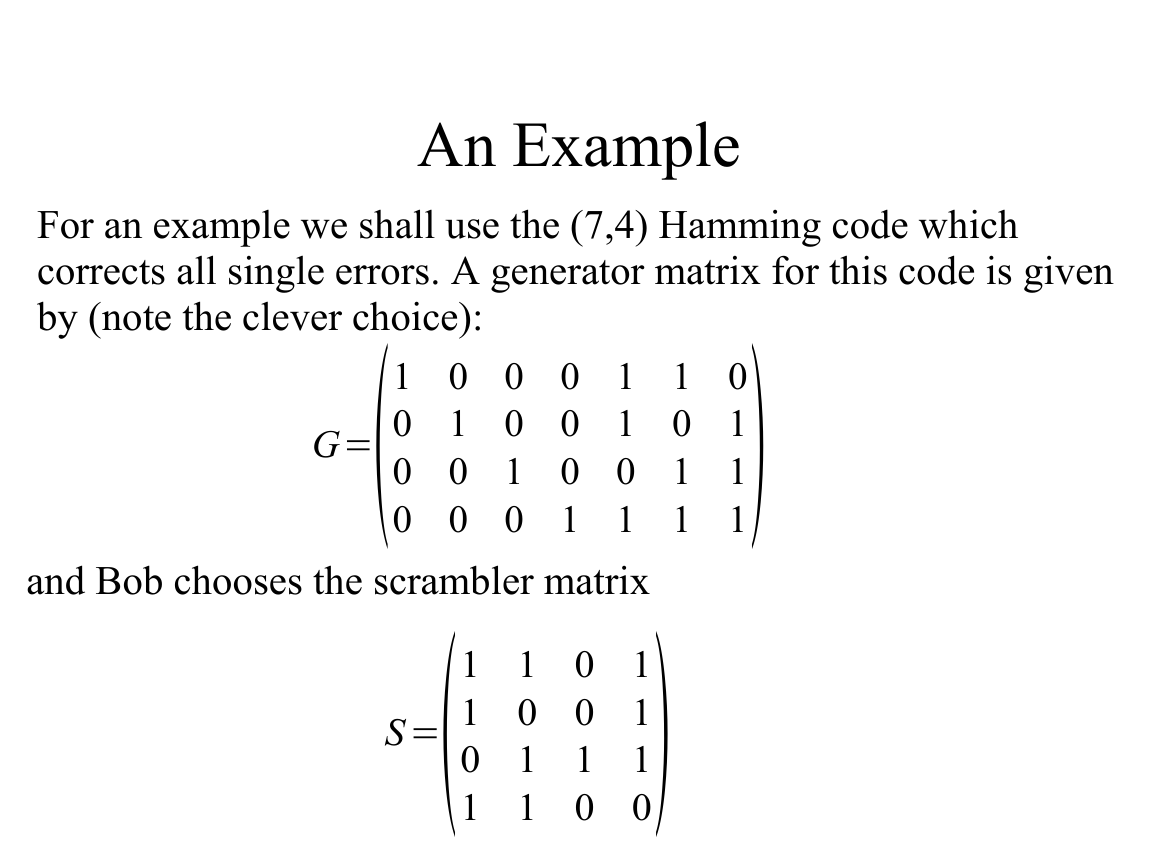









 2023年江西萍乡中考道德与法治真题及答案.doc
2023年江西萍乡中考道德与法治真题及答案.doc 2012年重庆南川中考生物真题及答案.doc
2012年重庆南川中考生物真题及答案.doc 2013年江西师范大学地理学综合及文艺理论基础考研真题.doc
2013年江西师范大学地理学综合及文艺理论基础考研真题.doc 2020年四川甘孜小升初语文真题及答案I卷.doc
2020年四川甘孜小升初语文真题及答案I卷.doc 2020年注册岩土工程师专业基础考试真题及答案.doc
2020年注册岩土工程师专业基础考试真题及答案.doc 2023-2024学年福建省厦门市九年级上学期数学月考试题及答案.doc
2023-2024学年福建省厦门市九年级上学期数学月考试题及答案.doc 2021-2022学年辽宁省沈阳市大东区九年级上学期语文期末试题及答案.doc
2021-2022学年辽宁省沈阳市大东区九年级上学期语文期末试题及答案.doc 2022-2023学年北京东城区初三第一学期物理期末试卷及答案.doc
2022-2023学年北京东城区初三第一学期物理期末试卷及答案.doc 2018上半年江西教师资格初中地理学科知识与教学能力真题及答案.doc
2018上半年江西教师资格初中地理学科知识与教学能力真题及答案.doc 2012年河北国家公务员申论考试真题及答案-省级.doc
2012年河北国家公务员申论考试真题及答案-省级.doc 2020-2021学年江苏省扬州市江都区邵樊片九年级上学期数学第一次质量检测试题及答案.doc
2020-2021学年江苏省扬州市江都区邵樊片九年级上学期数学第一次质量检测试题及答案.doc 2022下半年黑龙江教师资格证中学综合素质真题及答案.doc
2022下半年黑龙江教师资格证中学综合素质真题及答案.doc